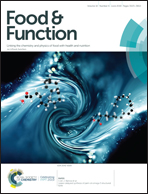Nutritive implications of dietary microRNAs: facts, controversies, and perspectives
Abstract
As a group of non-coding RNA molecules, microRNAs have recently become more well-known due to their pivotal role in gene regulation. A large number of endogenous microRNAs naturally occur in the human body, and some of them act as regulatory targets of diet and its components. The wide presence of microRNAs in various food materials has inspired food scientists and nutritionists to explore their nutritive and bioactive significance. This article comprehensively reports updated insights into the accessibility, stability, absorbability, and bioactivity of dietary microRNAs by combining the current knowledge into figures and tables for reader's convenience. As one frontier in food science and nutrition, the research platform on dietary microRNAs is imperfect and even defective as indicated by the inconsistent and even contradictory results concluded by different investigations. The pros and cons as well as the limitations of current investigations have been critically discussed with attention chiefly paid to experimental designs and protocols. Moreover, future research directions have been recommended. Thus, this paper may not only provide a quick glance at the state-of-the-art of dietary microRNAs but also guide further research to clarify the present controversies and make the results more credible and persuasive.



 Please wait while we load your content...
Please wait while we load your content...